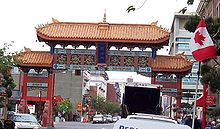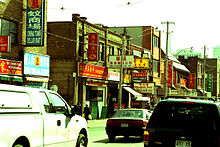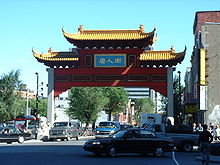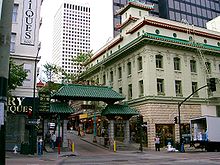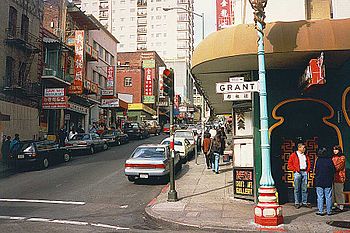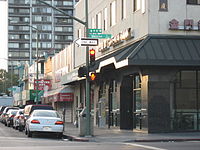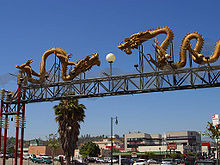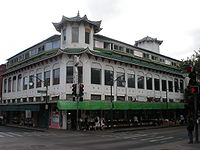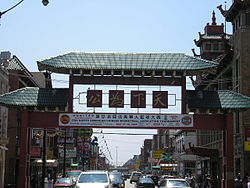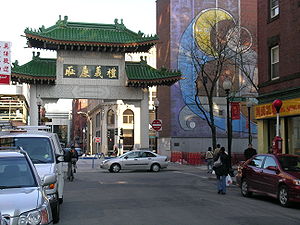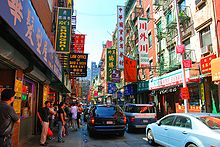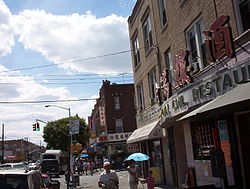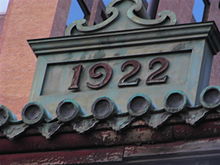- Chinatowns in Canada and the United States
-
Chinatown Chinatowns in Africa Chinatowns in Asia Chinatowns in Europe Chinatowns in Latin America Chinatowns in the Middle East Chinatowns in Canada and the United States Chinatowns in Oceania
This is a list of Chinatowns located in Canada and the United States.
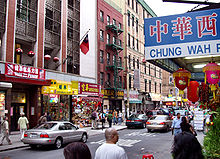 Manhattan's Chinatown, home to one of the highest concentrations of Chinese people in the Western Hemisphere, is the oldest of at least 7 Chinatowns in the New York City Metropolitan Area.
Manhattan's Chinatown, home to one of the highest concentrations of Chinese people in the Western Hemisphere, is the oldest of at least 7 Chinatowns in the New York City Metropolitan Area.
 Distinctive Chinese-style architecture characterizes the streets of San Francisco's historic Chinatown, the oldest and one of the largest in the United States.
Distinctive Chinese-style architecture characterizes the streets of San Francisco's historic Chinatown, the oldest and one of the largest in the United States.
Contents
- 1 Chinatowns in Canada
- 2 Chinatowns in the United States
- 3 Gallery of photographs
- 4 See also
- 5 References
- 6 Further reading
- 7 External links to Canadian and American Chinatowns
Chinatowns in Canada
Alberta
Edmonton
Main article: Chinatown and Little Italy, EdmontonThere are actually two Chinatowns in Edmonton: the newer Chinatown North (dominated by Hong Kong Chinese emigrants) and the older Chinatown South. Chinatown North stretches on 97 St from 107A Ave to 105 Ave and boasts mostly of shops, restaurants, and supermarkets. The Chinatown North has some strip malls including Lucky 97 Supermarket, Asia Square or Pacific Rim Mall. Chinatown South stretches on 102 Ave (Harbin Road) from 97 St to 95 St and south to Jasper Avenue, contains some restaurants, shops, residential buildings, and a multicultural centre. The older Chinatown south features a paifang from Edmonton's sister city, Harbin.
West Edmonton Mall has a themed street named Chinatown, with a lion's gate entrance, a koi pond, and a festive dragon. Asian-themed shops and services are available, anchored by a T & T Supermarket.
Calgary
Main article: Chinatown, CalgaryThe Chinatown in Calgary is the largest in Alberta. It spans 1 St E westward to 10 St W and from the Bow River southward to 4 Ave SW. This Chinatown consists of a large shopping centre called Dragon City Mall and a Calgary Chinese Cultural Centre located at 1 St SW. Nearly all of this is post-1930s, as Calgary's original Chinatown was little more than a handful of "Chinese and Western" restaurants in the same area, without the historic Chinese-ethnic residential-commercial quality of more historic Chinatowns like those in Vancouver.
Lethbridge
Lethbridge has the remains of a once thriving Chinatown. The Kuomintang and Chinese Freemasons buildings are about all that remain.
British Columbia
Vancouver
Main article: Chinatown, VancouverVancouver's Chinatown is the largest in Canada. Dating back to the late 19th century, the main centre of the older Chinatown is Pender and Main Streets in downtown Vancouver, which is also, along with Victoria's (Chinatown, Victoria), one of the oldest surviving Chinatowns in Canada and the United States, and has been the setting for a variety of modern Chinese Canadian culture and literature and innumerable Hollywood movies.
Vancouver's Chinatown contains numerous galleries, shops, restaurants, and markets, in addition to the Chinese Cultural Centre and the Dr. Sun Yat Sen Classical Chinese Garden and park; the garden is the first and one of the largest Ming era-style Chinese gardens outside China.[citation needed]
Vancouver's East Side has always had significantly Chinese residential areas and Chinese-market businesses are found throughout the city, 41st Avenue and Victoria Drive in the Kensington-Cedar Cottage neighbourhood in Vancouver, along Kingwway all the way from Mount Pleasant to Collingwood and the border with Burnaby, and on Hastings Street east from Chinatown proper. During the late 1980s, the cultural centre and destination point for Chinese Canadians had begun to shift away from the old Chinatown in downtown Vancouver, moving southward into the suburbs of the Lower Mainland, particularly to the Golden Village area in Richmond.[citation needed]
Richmond
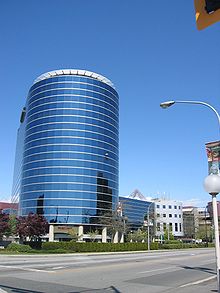 Richmond's Golden Village, the "new Chinatown" of the Greater Vancouver region.
Richmond's Golden Village, the "new Chinatown" of the Greater Vancouver region. Main article: Golden Village (Richmond, British Columbia)
Main article: Golden Village (Richmond, British Columbia)The Golden Village neighbourhood of Richmond, a suburb of Vancouver, is the exception to Canadian and American Chinatowns trends described above.[original research?] Unlike the Mandarin-dominated or the pan-Chinese new "Chinatowns" in the U.S., the shops and services in Richmond are mostly Hong Kong-centric. In local usage, Chinatown refers exclusively to downtown Vancouver's historic Chinatown district.[citation needed]
The Richmond area is 10 km south of Chinatown in downtown Vancouver near Highway 99 and Westminster Highway; the main corridor for Chinese-based retail is No. 3 Road. The Aberdeen Centre and Yaohan Centre are prominent malls for Chinese retailing.
Victoria
Main article: Chinatown, Victoria, British ColumbiaA very small Chinatown can be found in the provincial capital of Victoria, and as with most Canadian and American Chinatowns it is mostly touted as a tourist attraction. Chinatown is located within minutes walking distance of other Downtown Victoria shopping, entertainment, and cultural venues such as: Save On Foods Memorial Centre Arena, Bay Centre Mall, Market Square, Victoria, Centennial Square, Bastion Square. It is centred on Fisgard Street and is, along with the much larger one in downtown Vancouver, one of the oldest surviving historic Chinatowns in Canada and the United States. There are about two dozen Chinese-oriented businesses in this area.
Despite its small size, it was once the largest and oldest Canadian Chinatown on the West Coast of North America. It is the second oldest Chinatown after San Francisco's and it played an important part in local history, including the British Columbia Gold Rushes. Companies based here were the contractors for railway labour on the Canadian Pacific Railway (CPR) and Canadian National Railway (CNR). During the 20th Century, the second floor of the building on the southwest corner of Government and Fisgard Streets was the International Headquarters of the Chinese Communist Party. Records of Victoria's Chinese Benevolent Association,[1] the oldest Chinese-Canadian organization, display a wide range of pursuits including advocacy for full political equality as well as self-help and mutual aid activities.
The Victoria, BC Chinatown was made up of several streets (about 6 square city blocks, Chinatown, Victoria) at its highest population in around 1910–1911.
Other Chinatowns in British Columbia
- New Westminster's Chinatown
- Cumberland's Chinatown – once the second-largest on the West Coast of North America (c.1910)
- Stanley, British Columbia – a gold-mining community near Barkerville which became the largest town in the Cariboo goldfields after Barkerville's decline. In 1900 well over half its population was Chinese. Other towns in the Cariboo goldfields were also noticeably Chinese in composition – Richfield, Antler and others. Settlements in other areas which had Chinatowns, or which became predominantly Chinese for some of their lifespan, were Hazelton, Boston Bar, Rock Creek, Granite Creek and Fisherville (Wild Horse Creek). Cities which had now-vanished Chinatowns included Nanaimo and Penticton.
Manitoba
The Chinatown in Winnipeg was formed in 1909. It is on King Street between James and Higgins Avenues, and was officially designated in 1968. Some 20,000 Chinese live in the Winnipeg area.
Ontario
Ottawa
Ottawa's Chinatown area is in the Centretown West neighbourhood. It is centered on Booth Street and Somerset Street.[citation needed]
Toronto
Main article: Chinatown, TorontoToronto's original historic Chinatown centered around Dundas Street West and Elizabeth Street, running south to Queen Street West. Very little remains of this historic Chinatown except for a bit of architectural remnants on a couple of buildings on Dundas Street. The area experienced significant redevelopment in the 1960s, a large portion of the neighbourhood was destroyed to make way for the construction of new City Hall / Nathan Phillip Square and another large portion was cleared for the construction of the Holiday Inn Hotel, now a student residence for University of Toronto. As a result, the Chinese population and business owners moved further west to the current "old" Chinatown location at Spadina Avenue and Dundas Street West.
Spadina and Dundas Chinatown contains a large number of oriental businesses and includes two major shopping malls (Chinatown Centre and Dragon City) as well as four major supermarkets. The overall health of Chinatown has declined somewhat over the past 20 years due to the creation of newer Chinatowns / Chinese communities and the migration of the Chinese population to the suburban areas of the Greater Toronto Area; however, the decline has been counter-balanced to a degree due to an influx of a more diverse set of East Asian cultures, including Vietnamese, and Thai.
A smaller enclave known as East Chinatown is located in the Riverdale neighbourhood, centered at the corner of Broadview Avenue and Gerrard Street. Chinese-Vietnamese and mainland Chinese immigrants dominate this district which remains a relatively busy area.
Quebec
Montreal
Main article: Chinatown, MontrealMontreal's small, but well-frequented Chinatown is on rue De La Gauchetière and around rue Saint-Urbain and boulevard Saint-Laurent, between boulevard René-Lévesque and rue Viger (Place-d'Armes metro station), just a stone's throw away from the touristy Old Montreal (Vieux-Montreal). It was originally formed in the 1890s and has been the centrepiece for Chinese residing in the Montreal area.
The Chinatown is known as Quartier chinois in French.
Chinese businesses in Quebec enjoy a rare exception to that province's notorious language laws. When l'office de la langue française ordered restaurants and other businesses to replace their Chinese signs with signs where the French text is at least twice as large as Chinese, and without any English, Chinese businessmen protested that this was unlucky and bad for business. They were granted exemption from the province's strict sign laws on cultural grounds (which is not allowed other ethnic and cultural groups).[citation needed]
Quebec City
There was once a Chinatown on Côte d'Abraham in Quebec City, but Autoroute Dufferin-Montmorency cuts through what was once its location. Historically, it paled in size in contrast to its somewhat larger counterpart in Montreal. The first Chinese residents arrived in the late 19th Century. Most Chinese in the area operated business catering to their own: opium dens, mah-jongg, and Chinese laundries. The area peaked in the 1940s and 1950s. The separatist movement caused many to leave in the 1980s and 1990s. Some restaurants and a few Chinese residents remain. Most have moved to Montreal or Toronto.
The city has made attempts to re-establish a link to the past:
- a street was renamed Rue de Xi’an in 2006
- archway and park to be added shortly to commemorate the Chinese community of the past
Saskatchewan
Regina
Regina's Chinatown is found on 11th Avenue between Broad Street and Winnipeg Street. It features red bilingual street signs (in contrast to the standard English-only blue signs) and a few Asian groceries.
Saskatoon
In Saskatoon, the Chinatown can be found in the Riversdale district of that city.[citation needed]
Chinatowns in the United States
Many U.S. Chinatowns house recent immigrants and unskilled laborers who do not have good English proficiency. Once Chinese American families obtain higher level working skills and/or better jobs, they often move out of Chinatowns. AsianWeek said that Chinatowns have a necessary role, but that the role also makes them vulnerable.[2] Peter Kwong, an Asian American Studies professor at the Hunter College in New York City, said that many Chinatowns are vulnerable to redevelopment that would destroy them, since Chinese people often have the least political power of all of the groups in a typical city government.[2]
Arizona
Jerome - There was a small Chinatown in the 1870s[3]
Phoenix - Chinese immigrants working as railroad workers established the first Chinatown in downtown phoenix at First and Adams Street in the present location of US Airways Arena. All building have been torn down except for the Sun Mercantile Building.[4] A Chinatown-themed shopping center built to traditional Chinese architecture was opened in 1997 near the Phoenix Sky Harbor International Airport. It is called the Chinese Cultural Center and the offices are located at 668 N. 44st, a bit north of Van Buren St.
Prescott - Granite Street, between Goodwin and Gurley Street was the location of a Chinatown and more than 200 Chinese during late 19th and early 20th century. The area was razed in 1934 in order to make room for new construction.[5]
Tucson - A Chinatown began to form in Tucson after the railroad arrived in 1880. Tucson's Chinese population was very small and never exceeded 2% of the cities population. It's remaining and partly abandoned structures were demolished in 1968. However, in 1968 researchers discovered a complex called the "Ying On compound" still contained a group of working class elderly Chinese men.[6]
California
Given its relative proximity to East Asia and Southeast Asia, California has the largest number of Chinese among the American states,[7] including the well-known Chinatown in San Francisco, an all-Chinese town of Locke built by Chinese immigrants, and Chinatowns in various cities throughout the state.
Northern California
San Francisco
Main article: Chinatown, San Francisco, CaliforniaThe first, and one of the largest, most prominent and highly visited Chinatowns in the Americas is San Francisco's Chinatown, which is predominantly Cantonese-speaking, though many immigrants from Mainland China (mostly hailing from Guangdong province) are also fluent in Mandarin. Its main entrance is at Grant Avenue at Bush Street, but the center of Chinese commercial activities is on Stockton Avenue, whereas the section mostly oriented towards tourists is on Grant Avenue.
Arch to San Francisco's Chinatown.
Founded around 1850, Chinatown was destroyed in the 1906 San Francisco earthquake and was later rebuilt and re-realized, using a Chinese-style architecture that has been criticized as garish and touristy. According to Sunset Magazine, Chinatown receives millions of tourists annually, making the community, along with Alcatraz and Golden Gate Bridge, one of the prime attractions and highlights of the city of San Francisco, as well as the centerpiece of Chinese-American history. With its Chinatown as the landmark, the city of San Francisco itself has one of the largest and predominant concentrations of Chinese-American population centers, representing 20% of total population as of the 2000 Census, even more than New York City in terms of proportional numbers according to anthropologist Bernard Wong. While many ethnic Chinese do not reside in Chinatown today, but instead throughout the city of San Francisco as well as the surrounding Oakland and San Jose areas, Chinatown remains the historical anchor. It has also remained the symbolic center as city politicians and candidates have made it a de rigueur stop during election campaigns. Historically and today, Chinese in America refer to San Francisco in Cantonese as Die Foul (大埠, which can be translated as 大城, da cheng in Mandarin or the Big City in English.)
Besides the main thoroughfare of Grant Avenue and various side streets, Chinatown has several side alleys, including Ross Alley. Contained within this alley is a mix of touristy stores, tiny barber shop (once patronized by famous singer Frank Sinatra) as well as a fortune cookie factory. Ross Alley used to have brothels, but they no longer exist.
Also within the confines of Chinatown is the Woh Hei Yuen Recreation Center and Park on Powell Street. Many Chinese-speaking old-timers are frequent patrons this park because their lodgings – generally intended for low-income persons – tend to be tiny and cramped. Many elderly people gather to play mahjong, Chinese poker, perform t'ai chi exercises in the morning, read a Chinese newspaper, or simply to lounge around.
The San Francisco Chinatown hosts the largest Chinese New Year parade in the Americas, with corporate sponsors such as the Bank of America and the award-winning and widely praised dragon dance team from the San Francisco Police Department, composed solely of Chinese-American SFPD officers (the only such team in existence in the United States). In its founding, it received the grant from the Chinese Consolidated Benevolent Association, otherwise known as the Chinese Six Companies. As Chinatown and many Chinese-Americans in the San Francisco Bay Area have historical or current roots in province of Guangdong, China (particularly Taishan County) and in Hong Kong, these dances mostly are performed in the southern Chinese style.
The first Chinese-American police chief in the United States, Fred Lau, of the SFPD, grew up in San Francisco Chinatown. The current SFPD Chief of Police, Heather Fong, was also born and raised in Chinatown. At the start of her police career, Fong was a key investigator of the notorious 1977 Golden Dragon massacre in Chinatown.
San Francisco Chinatown has been shown in numerous movies and television shows, and boasts a number of firsts, including the invention of chop suey, being the site of printing currency for the then-newly emerged Republic of China, and the first Chinese Consolidated Benevolent Association. During the civil rights movement of the 1960s, San Francisco's Chinatown was also at the center for Chinese-American activism and radical politics, some of which was militant, as well as major gang activity with the emergence of the notorious Wah Ching in the Americas. Currently, the historic Chinatown shows some signs of decline.
After President Richard M. Nixon's historic 1972 visit to the People's Republic of China, the arrival of new Chinese immigrants to the San Francisco area helped diversify and introduce new Chinese cuisine from many regions throughout mainland China in its Chinatown—the restaurants previously served mainly Cantonese and unauthentic Chinese-American fare.
Today, as with most Chinatowns in or near congested urban centers, parking problems still continue to plague the area, which has implications on the economy of the enclave. Due to the aging infrastructure which pre-dated the advent of the motor vehicle, it has been said nothing could be done by the municipal government of San Francisco to alleviate such problems. Many principal ethnic Chinese residents and frequenters of Chinatown are elderly and do not speak much English and in terms of transportation have very limited mobility and remain in Chinatown for shopping and social services through the local associations.
Oakland
Main article: Chinatown, OaklandOakland's Chinatown is frequently referred to as "Oakland Chinatown" in order to distinguish it from nearby San Francisco's Chinatown. Originally formed in the 1860s, the Chinatown of Oakland – centering upon 8th Street and Webster Street – shares a long history as its counterpart in the city of San Francisco as Oakland's community remains one of the focal point of Chinese American heritage in the San Francisco Bay Area. However, the major difference with San Francisco's Chinatown is that Oakland's version is not as touristy as its local economy tends not to rely on tourism as much. But the local government of Oakland has since promoted it as such as it is considered one the top sources of sales tax revenue for the city. The Chinatown does not have an ornamental entrance arch (paifang) but the streets of the community are adorned with road signs in English with Chinese rendering.
Today, while it remains a Cantonese-speaking enclave "Chinatown" is not exclusively Chinese anymore, but a vibrant pan-Asian neighborhood which reflects Oakland's rich diversity of Asian community of Chinese, Vietnamese, Korean, Filipinos, Japanese, Cambodian, Laotian, Mien, Thai, and others. In a matter of 12 city blocks, one can expect to find in this Chinatown a collection of groceries, restaurants, stores (offering products such as ginseng and herbs, jewelry, and so on), clinics, the Oakland Asian Cultural Center (9th Street), and habitations for elderly immigrants, as well as a local branch of the Oakland Public Library filled with Asian materials and collections. In addition to the standard Chinese New Year festivities, the Oakland Chinatown Streetfest (as held by the Oakland Chinatown Chamber of Commerce) is also held yearly in August and it features Chinese lion dances, parades, music, cooking demonstrations and contests, a food festival, and various activities.
San Jose/Silicon Valley
While the city of San Jose proper did have several Chinatowns in the past, they are all extinct today.
Sacramento
Sacramento has a relatively small urban Chinatown, which dates back to the early days of the California Gold Rush. Generally, it now serves more as a museum than anything else.
Stockton
In Stockton, California still exists a small Chinatown on Chung Wah Lane, East Market Street and East Washington Street. Although it is a very small area, there are some Chinese stores in it as well as restaurants such as On Lock Sam, the city's oldest restaurant, founded in 1898. The community was once quite large but, after development in the 1950s and 1960s and the construction of the Crosstown freeway, businesses moved, buildings were demolished, new buildings were built, and the community changed forever. There is still a Chinese New Year Parade merged with the Vietnamese New Year celebrations.
Locke
Just beyond the Sacramento and Stockton areas, the small town of Locke is an example of an early rural "Chinatown" completely built by Chinese immigrants in 1915. Consisting of only three streets in town (Main Street, River Road, and Key Street), it was a thriving community with various merchants and associations as its economy based mostly on the agriculture. Very few ethnic Chinese live there these days. The Dai Loy Museum – dai loy(大來) literally renders as "big come" in Taishanese – as well as one Chinese restaurant offering a mixture of traditional Cantonese and Americanized Chinese food are features in Locke. In the early 1980s, a 30-minute documentary from the University of California, Berkeley called American Chinatown, which documented the last surviving immigrant old-timers as well as battles with land developers and the touristification of the community.
Fresno and Central Valley
Work is underway to revitalize Fresno's once-moribund Chinatown, founded in 1885 at F Street in the San Joaquin Valley city. It is undergoing a massive beautification project. However, currently the area is not exclusively Chinese. One of the major problems is that there are fewer Chinese businesses there. But the area already holds an annual Chinese New Year celebration. The Chinatown Revitalization Inc has been making several efforts to support the Chinatown of Fresno.
The town of Hanford, about 30 miles distance from Fresno, features a ramshackle Chinatown from the 19th century era, mostly contained within a small street block known as China Alley. Many early immigrants arrived from the Sam Yup region (or Sanyi in modern pinyin) in the province of Guangdong, China. Many of its multigeneration American-born Chinese descendants of original settlers have since moved on. Chinatown had its early share of opium dens and brothels. In modern times, all that still stands of China Alley is a Taoist temple (a monument officially recognized by the National Register of Historic Places) and a special museum.
Southern California
Inland Empire
Several cities of the Inland Empire region once had standing Chinatowns, including the former farming communities of San Bernardino, Riverside, and Redlands.
San Bernardino's Chinatown, pioneered in the late 1870s, occupied Third Street between Arrowhead and Mountain View. During its peak in the 1890s, the community flourished with several Chinese habitations and community trades, such as shops. By the 1920s, Chinatown experienced decline and the last remnants of Chinatown fell into obscurity in 1959.
The Chinatown in Redlands was on what is now Oriental Avenue and Texas Street. It is no longer extant.
The Chinatown of Riverside was established in 1885. The remaining Chinese American survivor of Riverside's Chinatown died off in 1974. He attempted to preserve Chinatown, but his efforts were in vain because the last remnant of Riverside's Chinatown was razed in 1978. As with many early Chinatowns in the small and medium-sized towns of California, the once vibrant Chinese American history has faded into obscurity.
Los Angeles
Main article: Chinatown, Los AngelesThien Hau Temple, another popular attraction in Los Angeles New Chinatown.
In the city of Los Angeles proper, the old inner-city Chinatown was built during the late 1930s–the second Chinatown to be constructed in Los Angeles. Formerly a "Little Italy," it is presently located on Broadway Avenue and Spring Street near Dodger Stadium in downtown Los Angeles with still several restaurants, grocers, and tourist-oriented trinket shops. A statue honoring the Kuomintang founder Dr. Sun Yat-sen adorns the more touristy area in the northeast section. Chinatown is home to several family and regional associations and general service organizations for old-timer immigrants (called in Cantonese lo wah cue) as well as ones founded by and for the new immigrants from Southeast Asia. The enclave contains Buddhist temples, Chinese Christian church (with services conducted in Cantonese), and a temple devoted to the Chinese Goddess of the Sea.
San Diego
San Diego's Chinatown was founded in the 1870s around Market Street and Third Avenue, but faded quickly after World War Two. In 1987, due to its historic and cultural value, the city council of San Diego sought to preserve the area and officially designated it the Asian Pacific Thematic Historic District, which partially overlaps the burgeoning and gentrified Gaslamp Quarter Historic Distrcit (the center of the San Diego's trendy nightlife scene). The annual San Diego Chinese New Year Food and Cultural Faire is presented in this particular district, and the San Diego Chinese Heritage Museum is located here.
San Luis Obispo
There is a nearly forgotten "Chinatown" from the middle 1870s on Chorro Street and Palm Street in the Central Coast town of San Luis Obispo. An early Chinese store was owned by early Chinese immigrant pioneer and influential community leader Ah Louis. It is now considered a historic relic. Also, many Chinese artifacts of the community have since been discovered during excavations. Railroad Square features a statue that honors the Chinese immigrant laborers who worked on the railroads in the vicinity of San Luis Obispo.
Hawaii
Honolulu
Main article: Chinatown, HonoluluThe official and historic Chinatown of Honolulu, on North Hotel Street and Maunakea Street, contains traditional ethnic Chinese businesses. Unlike Chinatowns in the continental United States which were largely pioneered and dominated by Taishan immigrants, Honolulu's Chinatown was started by early settlers from Zhongshan, Guangdong province in the 1890s. They migrated to Hawaii for work in the island's cane sugar plantations as well as rice fields and then as they became successful eventually relocating to the city of Honolulu. As with other Chinatowns in the United States, it was noted for its unsanitary conditions. In the 1940s, it degenerated into a red-light district.
Today, it is also diverse with Pan-Asian and Pacific Islander businesses and the ethnic Chinese from Vietnam are largely demographically represented in Honolulu's Chinatown. Businesses include markets, bakeries, Chinese porcelain shop, and shops specializing with gingseng herbal remedies. In Chinatown, there are also bazaars and street peddlers in the Kekaulike Mall (located on Kekaulike Street) bringing it unique bustling ambiance to the community. The variety of restaurants serving Hong Kong-style dim sum and others in Vietnamese beef noodle soup are frequent in Chinatown. The history of Chinese revolutionary Sun Yat-sen – from the Zhongshan region of Guangdong province of China – is tied to Hawaii, having receiving his Western education there. Chinatown, Honolulu was once served as the base of operations in a series of crusades against ruling Qing Dynasty in China that culminate in the Revolution of 1911. There is a monument in his honor in Honolulu's Chinatown. Recent development and planning has dramatically transformed the once decaying and unsafe neighborhood to an upscale Asian inspired arts district blended with the traditional Chinese bazaars and family owned stores.
Illinois
Chicago
Main article: Chinatown, Chicago, IllinoisThe Chinatown in Chicago is a traditional urban Chinatown occupying the area along Wentworth Avenue at Cermak Road south of downtown. This area has historically been dominated by commerce, though in recent years, residential developments have greatly increased the number of people living in the area. With restaurants, markets, shops, associations, and community services, this original Chinatown particularly attracts Chinese emigres hailing from China. The annual Chinese New Year and Chinese Double Ten Day Parade are held in Chinatown.
Chicagoans also refer to a Southeast Asian community on Argyle Street in the north side as the "New Chinatown", or alternatively, as "Little Chinatown".[citation needed] But at this point, this "new" chinatown still pales in size and scope to the more traditional chinatown. This so-called "Chinatown" is actually inhabited by the minority ethnic Chinese who were born in Vietnam and Cambodia.
Louisiana
New Orleans
The first significant migration of Chinese into Louisiana took place during Reconstruction after the American Civil War, when local planters imported hundreds Cantonese contract workers from Cuba and California as a low-cost substitute for slave labor.[8] By 1870, the Chinese were abandoning the plantations and finding work in the cities, especially New Orleans, and by the 1880s, a flourishing Chinatown had formed on the 1100 Block of Tulane Avenue, near Elk Place, in the Faubourg Ste. Marie. When it existed, New Orleans Chinatown was the largest Chinatown in the American South.[9] The Chinese came to dominate the laundry industry of the city during this era, as they had in other American cities. The original unskilled laborers were joined by merchants from San Francisco, who operated businesses to service the growing Chinese population in the region and to profit from trade at the Port of Orleans.
But in 1937, nearly all of the Faubourg Ste. Marie, including Chinatown, was demolished by WPA development to build the modern Central Business District.[10] The former site of Chinatown is now the Tulane Medical Center. The Chinese attempted to build a second Chinatown on the 500 block of Bourbon Street in the French Quarter. In the 1940s, this section of Bourbon was still predominantly residential. But by then, the younger generation of American-born Chinese were abandoning the laundry industry and migrating to the suburban eastbank of Jefferson Parish, where much of the Chinese population lives today. Only a few Chinese businesses successfully migrated to the French Quarter Chinatown, which was abandoned in subsequent years.
Today, nearly all traces of the historic New Orleans Chinatown have been obliterated. The only surviving marker of New Orleans Chinatown is the On Leong Association's painted sign over the door of their former meeting hall at 530 Bourbon.[11]
Maryland
Baltimore
There existed a Chinatown on Park Ave. in Baltimore, which was dominated by laundries and restaurants. A few Chinese restaurants and groceries remain on Park Ave. between West Franklin Street and West Saratoga Street.
Massachusetts
Boston
Main article: Chinatown, BostonThe sole established Chinatown of New England is in Boston, on Beach Street and Washington Street near South Station between Downtown Crossing and Tufts Medical Center. There are many Chinese, Japanese, Cambodian and Vietnamese restaurants and markets.
In the pre-Chinatown era, the area was settled in succession by Irish, Jewish, Italian and Syrian immigrants as each group replaced another. Syrians were later succeeded by Chinese immigrants, and Chinatown was established in 1890. From the 1960s to the 1980s, Boston's Chinatown was located in the Combat Zone, which served as Boston's red light district, but sandwiched between the dual expansions of Chinatown from the East and Emerson College from the West, the Combat Zone has shrunk to almost nothing.[citation needed]
Currently, Boston's Chinatown is experiencing a threat from gentrification policies as large luxury residential towers are built in and surrounding an area that was overwhelmingly three, four, and five-story small apartment buildings intermixed with retail and light-industrial spaces.[12][13]
Several Boston suburbs -- notably Quincy -- have developed their own Chinatowns in response to this pressure.
Michigan
Detroit
Detroit's Chinatown was originally located at Third Avenue, Porter St and Bagley St, now the permanent site of the MGM Grand Casino.[14] In the 1960s, urban renewal efforts, as well as the opportunity for the Chinese business community to purchase property led to a relocation centered at Cass Avenue and Peterboro.[15] However, Detroit's urban decline and escalating street violence, primarily the killing of restaurateur, Tommie Lee, led to the new location's demise, with the last remaining Chinese food restaurant in Chinatown finally shut its doors in the early 2000s. Although there is still a road marker indicating "Chinatown" and a mural commemorating the struggle for justice in the Vincent Chin case, only one Chinese American establishment still operates within the borders of the City of Detroit. The Association of Chinese Americans Detroit Outreach Center,[16] a small community center, serves a handful of new Chinese immigrants who still reside in the Cass Corridor.
Missouri
St. Louis
St. Louis' original Chinatown, also called "Hop Alley", was in the city of St. Louis, Missouri[17] before it was eventually replaced by Busch Stadium in the 1960s. During its prime, it had a plethora of hand laundries, but later Chinese restaurants became the primary economic source. An effort to establish a new china town in University City, Missouri has had partial success. Several Chinese businesses and restaurants populate the area. The current problem facing the new Chinatown is that not many Chinese residents choose to live there.
Nevada
Las Vegas
Main article: Chinatown, Las VegasThe only Chinatown in Las Vegas was initially just a large shopping center called "Chinatown Plaza." It is the so-called "first master-planned Chinatown in America" with the Chinese American supermarket chain 99 Ranch Market serving as its anchor. The plaza location is west of the Las Vegas Strip and Interstate 15 at 4255 Spring Mountain Road, just outside the casino areas in what is a typical American neighborhood. The area has been officially designated "Chinatown" by Nevada governor Kenny Guinn and by city of Las Vegas with parking areas allotted for buses as well. (The Chinatown has its own designated exit off-ramp sign on Interstate 15.) Furthermore, the Chinese American population tends to be somewhat more dispersed throughout Las Vegas than in Southern California.
New Jersey
Newark
Chinatown, Newark, was a Chinese enclave in Downtown Newark, New Jersey, that thrived in the late 19th century and the first half of the 20th century and was centered around Mulberry Arcade.
New York
New York City
The New York City Metropolitan Area contains the largest ethnic Chinese population outside of Asia, enumerating 665,714 individuals as of the 2009 American Community Survey Census statistical data,[18] including at least 7 Chinatowns, comprising the original Manhattan Chinatown, two in Queens (the Flushing Chinatown and the Elmhurst Chinatown), three in Brooklyn (the Sunset Park Chinatown, the Avenue U Chinatown, and the Bensonhurst Chinatown), and one in Edison, New Jersey, not to mention fledgling ethnic Chinese enclaves emerging throughout the New York metropolitan area. Chinese Americans, as a whole, have had a (relatively) long tenure in New York City. The first Chinese immigrants came to Lower Manhattan around 1870, looking for the "gold" America had to offer.[19] By 1880, the enclave around Five Points was estimated to have from 200 to as many as 1,100 members.[19] However, the Chinese Exclusion Act, which went into effect in 1882, caused an abrupt decline in the number of Chinese who immigrated to New York and the rest of the United States.[19] Later, in 1943, the Chinese were given a small quota, and the community's population gradually increased until 1968, when the quota was lifted and the Chinese American population skyrocketed.[19]
Manhattan
Main article: Chinatown, ManhattanThe Manhattan Chinatown (simplified Chinese: 纽约华埠 ; traditional Chinese: 紐約華埠; pinyin: Niŭyuē Huá Bù), the historical focus of one of the largest concentrations of Chinese people in the Western Hemisphere, is located in the borough of Manhattan in New York City. Within Manhattan's expanding Chinatown lies a Little Fuzhou on East Broadway and surrounding streets, occupied predominantly by immigrants from the Fujian Province of Mainland China. Areas surrounding the "Little Fuzhou" consist mostly of Cantonese immigrants from Guangdong Province, the earlier Chinese settlers, and in some areas moderately of Cantonese immigrants. In the past few years, however, the Cantonese dialect that has dominated Chinatown for decades is being rapidly swept aside by Mandarin, the national language of China and the lingua franca of most of the latest Chinese immigrants.[20] The energy and population of Manhattan's Chinatown are fueled by relentless, massive immigration from Mainland China, both legal and illegal in origin, propagated in large part by New York's high density, extensive mass transit system, and huge economic marketplace.
The early settlers of Manhattan's Chinatown were mostly from Taishan and Hong Kong of the Guangdong Province of China, which are the Cantonese speakers and also from Shanghai.[21] They form most of the Chinese population of the area surrounded by Mott and Canal Streets.[21] The later settlers, from Fuzhou, Fujian, form the Chinese population of the area bounded by East Broadway.[21] Chinatown's modern borders are roughly Grand Street on the north, Broadway on the west, Chrystie Street on the east, and East Broadway to the south.[21]
Queens
Main article: Chinatown, FlushingThe Flushing Chinatown, in the Flushing area of the borough of Queens in New York City, is one of the largest and fastest growing ethnic Chinese enclaves outside of Asia, as well as within New York City itself. Main Street and the area to its west, particularly along Roosevelt Avenue, have become the primary nexus of Flushing Chinatown. However, Chinatown continues to expand southeastward along Kissena Boulevard and northward beyond Northern Boulevard. In the 1970s, a Chinese community established a foothold in the neighborhood of Flushing, whose demographic constituency had been predominantly non-Hispanic white. Taiwanese began the surge of immigration, followed by other groups of Chinese. By 1990, Asians constituted 41% of the population of the core area of Flushing, with Chinese in turn representing 41% of the Asian population.[22] However, ethnic Chinese are constituting an increasingly dominant proportion of the Asian population as well as of the overall population in Flushing and its Chinatown. A 1986 estimate by the Flushing Chinese Business Association approximated 60,000 Chinese in Flushing alone.[23] Mandarin Chinese (including Northeastern Mandarin), Fuzhou dialect, Min Nan Fujianese, Wu Chinese, Beijing dialect, Wenzhounese, Shanghainese, Cantonese, Taiwanese, and English are all prevalently spoken in Flushing Chinatown. Even the relatively obscure Dongbei style of cuisine indigenous to Northeast China is now available in Flushing Chinatown.[24] Given its rapidly growing status, the Flushing Chinatown may surpass in size and population the original New York City Chinatown in the borough of Manhattan within a few years, and it is debatable whether this has already happened.
Elmhurst, another neighborhood in the borough of Queens, also has a large and growing Chinese community.[25][26] Previously a small area with Chinese shops on Broadway between 81st Street and Cornish Avenue, this newly evolved second Chinatown in Queens has now expanded to 45th Avenue and Whitney Avenue.
Brooklyn
Main article: Chinatown, BrooklynBy 1988, 90% of the storefronts on Eighth Avenue in the Sunset Park, in southern Brooklyn, had been abandoned. Chinese immigrants then moved into this area, not only new arrivals from China, but also members of Manhattan's Chinatown, seeking refuge from high rents, who fled to the cheap property costs and rents of Sunset Park and formed what the website of the local branch of the Chinese Benevolent Association has called "the Brooklyn Chinatown",[27] which now extends for 20 blocks along 8th Avenue, from 42nd to 62nd Streets. This relatively new but rapidly growing Chinatown located in Sunset Park, Brooklyn was originally settled by Cantonese immigrants like Manhattan's Chinatown in the past. However, in the recent decade, an influx of Fuzhou immigrants has been pouring into Brooklyn's Chinatown and supplanting the Cantonese at a significantly higher rate than in Manhattan's Chinatown, and Brooklyn Chinatown is now home to mostly Fuzhou immigrants. In the past, during the 1980s and 1990s, the majority of newly arriving Fuzhou immigrants were settling within Manhattan's Chinatown, and the first Little Fuzhou community emerged in New York City within Manhattan's Chinatown; by the 2000s, however, the epicenter of the massive Fuzhou influx had shifted to Brooklyn Chinatown, which is now home to the fastest growing and perhaps largest Fuzhou population in New York City. Unlike the Little Fuzhou in the Manhattan Chinatown, which remains surrounded by areas which continue to house significant populations of Cantonese, all of Brooklyn's Chinatown is swiftly consolidating into New York City's new Little Fuzhou. However, a growing community of Wenzhounese immigrants from China's Zhejiang Province is now also arriving in Brooklyn Chinatown.[28] Also in contrast to Manhattan's Chinatown, which still successfully continues to carry a large Cantonese population and retain the large Cantonese community established decades ago in the western section of Manhattan's Chinatown, where Cantonese residents have a communal gathering venue to shop, work, and socialize, Brooklyn Chinatown is very quickly losing its Cantonese community identity.[29]
Ohio
Cleveland
Cleveland's Chinatown (renamed Asiatown in 2006)[30] is one of several ethnic communities within the city proper, along with Little Italy and Slavic Village. The neighborhood is centered around St. Clair, Superior, and Payne Avenues just east of the central business district. The area also falls into the district limits of the Quadrangle which includes several colleges and mid-rise offices and light industrial areas.
Oklahoma
Oklahoma City
Main article: Asia DistrictOklahoma City's Chinatown, known as Asia District (or also the Asian District), represents a new trend in major cities in the United States that traditionally did not have a concentrated Asian population. Today's Asia District has transformed a once blighted urban area near Oklahoma City University north of downtown into a myriad of restaurants, Asian supermarkets, shoppes, and galleries popular with the rapidly growing mosaic of Asian residents of the city. Most of the businesses in the area, such as markets and restaurants, tend to be run by Vietnamese or Chinese American immigrants.
The area began as a Little Saigon back in the mid-1980s due to the more than 17,000 Vietnamese refugees that inhabited the area at that time, but was recently renamed by the city to Asia District to better reflect the true colors of the neighborhood.
There was once a historic Chinatown located in Downtown Oklahoma City, in tunnels under what is now the Cox Convention Center. The area was inhabited by the first Chinese immigrants who came to the area via the railroad around the 1950s.
Oregon
Portland
Main article: Old Town Chinatown, Portland, OregonThere is a Chinatown, on NW 4th Ave. just north of W Burnside St., in the Old Town Chinatown district of Portland. It is not very active and contains no actual Chinese markets. Unfortunately, many storefronts have remained abandoned for some time and not many Chinese restaurants remain. Some of the restaurants are the historic chop suey restaurant, Good Taste which serves Cantonese BBQ and noodle soups, Golden Horse which serves a variety of dishes but specializes in seafood dishes, Fong Chong which serves dim-sum, and House of Louie which also serves dim-sum and other Chinese dishes. The Republic Cafe is reported to be the oldest Chinese restaurant in Portland. The building of the Portland chapter of the Chinese Consolidated Benevolent Association still remains in Chinatown and it is open to the public. Unlike other Chinatowns in other cities, the population of Chinatown has not been renewed by later waves of immigration.
The Portland Classical Chinese Garden, located on NW 3rd Ave. and NW Everett St., is also a major feature in Chinatown. It was designed by artisans from Suzhou, China.
Given the expensive rents and tourist orientation of Chinatown and following the dual Chinatown pattern as present in several major metropolitan areas of the Americas, the thoroughfare of SE 82nd Ave. in Montavilla neighborhood of Portland is home to the city's newer Chinese business district, already with immigrant-oriented markets, Chinese seafood restaurants, and Vietnamese noodle eateries. It has been already picked up by the media as a "new chinatown". The Montavilla area has moderate drug problems.[31]
Pennsylvania
Philadelphia
Main article: Chinatown, Philadelphia, PennsylvaniaThere is a Chinatown centered around 10th and Race Streets in Philadelphia. Over the years, several blocks were lost to the Pennsylvania Convention Center, and the Vine Street Expressway. For the past few years, city officials have restricted redevelopment in Chinatown, particularly as a result of efforts by a coalition of grassroots groups (pan-ethnic, labor groups) working together to preserve Chinatown. Today the lost blocks have been regained by the expansion of Chinatown to Arch Street and north of Vine Street. Asian restaurants, funeral homes, and grocery stores are common sights. Philadelphia's Chinatown residents are mostly of Chinese, Vietnamese, Thai, and Cambodian peoples. Korean, Japanese, and Filipinos are also residents. Chinatown contains a mixture of businesses and organizations owned by the pan-Chinese diaspora, as Mainland Chinese, Vietnamese Chinese, Hong Kong Chinese, and Malaysian Chinese residing in the Philadelphia area call Chinatown home.
Pittsburgh
A now defunct Chinatown was located on Grant Street and Boulevard of the Allies in Pittsburgh, where two Chinese restaurants remain. The On Leong Society was located there. The Chinese population in Pittsburgh has grown recently . Newer stores exist on Penn Avenue near 18th Street in the Strip District. Chinese live in various neighborhoods throughout the city and suburbs.
Texas
Houston
Main article: Chinatown, HoustonYet another example of the new-Chinatown/old-Chinatown contrast is Houston, where there is an old and largely disappearing Chinatown near the Convention Center on Chartres Street and McKinney Street in Downtown Houston.
Houston's Chinatown is not as high-profile as others like it around the Americas. Chinatown in eastern downtown retains a few restaurants but no habitations. To reverse the decline of Chinatown in Downtown Houston, business leaders have attempted to lure tourists as plans have been drawn up to develop a Chinese paifang on McKinney Street as its entryway.
El Paso
Archaeological work has been done to uncover the long history of El Paso's Chinatown, which stood from 1881 to around the 1920s. The area is significant in which it attracted a large number of Chinese workers in the American Southwest and there a Chinatown sprung up.
Washington
Main article: International District, Seattle, WashingtonSeattle
Seattle's current Chinese neighborhood came into being around 1910 when much of the former Chinatown along Washington Street was condemned for street construction. The Chinese population began rebuilding along King Street, south of Seattle's Nihonmachi. Chinese investors pooled their resources to build several substantial buildings to house businesses, organizations and residences, such as the East Kong Yick Building.
In the 1950s Seattle officials designated Chinatown as part of the International District (I.D.) due to the diverse Asian population that, by then, included Chinese, Japanese, Filipinos, and Koreans. By the late 1970s, Vietnamese immigrants also formed a Little Saigon next to Chinatown, within the ID.
There has been some controversy over the name "International District." Some local Chinese Americans reject the term, preferring the historic designation "Chinatown" for the area as a source of pride. Others, especially American born generations of Asians, accept the ID designation as more appropriate due to their embrace of a more "pan-Asian" identity. Subsequently, the city redesignated the area the Chinatown-International District.
Olympia
Olympia's small Chinatown is no longer extant. It formed initially on Fourth Avenue near Capital Way, not long after Olympia was founded. It moved in the 1880s to Fifth Avenue and then to Water Street in the 1910s. The remaining buildings were razed in 1943 after the last few residents departed. The city placed an historical marker at the site of Olympia's last Chinatown at the north end of Capitol Lake in 2004.
Spokane
A fair sized Chinatown existed in Spokane for years that started when the railroad came through in 1883. It consisted of a network of alleys between Front Avenue (today's Spokane Falls Boulevard) and Main Avenue that stretched east from Howard Avenue to Bernard Street about four blocks. The Chinese population gradually thinned out until the alley became practically abandoned by the 1940s. All the remains of Chinatown were demolished for parking for Spokane's Expo '74.
Tacoma
There was also a significant historic Chinatown located in Downtown Tacoma. In November 1885 disgruntled whites drove out the Chinese population and burned down Chinatown. Recently, a special remembrance garden called the Chinese Reconciliation Park has been built a short distance away.[32]
Washington, D.C.
Main article: Chinatown, Washington, D.C.The old Chinatown of Washington, D.C. is on I Street and H Street, from 5th to 7th St NW. Today, it has roughly 10 Chinese restaurants, mostly geared towards tourists. It has been part of a redevelopment movement occurring in the Downtown Washington, D.C. area. Mainstream restaurant and retail chains have mostly filled in Chinatown.
Gallery of photographs
-
Old buildings in Pittsburgh
See also
Chinese Canadians Topics Chinese Canadian · History of Chinese immigration to Canada · Chinese Immigration Act of 1885 · Chinese Canadians · List of Canadian cities with large Chinese populations · Canadian Chinese cuisine · Chinese Canadian National Council · Canadians of Taiwanese descent · List of Chinese CanadiansChinatowns and
Chinese communitiesReferences
- ^ Chinese Benevolent Association
- ^ a b AsianWeek Staff and Associated Press. "Philadelphia Chinatown Wins Stadium Fight. AsianWeek. November 24-30, 2000. Retrieved on November 8, 2011.
- ^ Chinese Immigration into Arizona Territory
- ^ Row over Chinatown landmark stirs memories
- ^ The History of Prescott's Chinatown
- ^ The Chinese of Early Tucson. Historic Archaeology from the Tucson Urban Renewal Project. Florence C. Liester and Robert H. Lister. University of Arizona Press, Tucson, 1989. x, 129 pp
- ^ Asian American/Pacific Islander Profile - The Office of Minority Health
- ^ Cohen, Lucy (1984). Chinese in the Post-Civil War South. LSU Press.
- ^ Campanella, Richard (Fall 2007). "Chinatown New Orleans". Louisiana Cultural Vistas. http://www.nxtbook.com/nxtbooks/leh/lcv-fall07/index.php?startid=50.
- ^ Campanella, Richard (Fall 2007). "Chinatown New Orleans". Louisiana Cultural Vistas. http://www.nxtbook.com/nxtbooks/leh/lcv-fall07/index.php?startid=57.
- ^ Temple, Shao-mei Deng. "Discovering the Forgotten New Orleans Chinese Quarter". Asia Pacific American Society of New Orleans. http://www.apasneworleans.com/asianbayou/lotus_roots_project.htm.
- ^ Palmer Jr, Thomas C. (2006-03-01). "Hotel project revived in Theater District". The Boston Globe. http://www.boston.com/business/articles/2006/03/01/hotel_project_revived/.
- ^ A land squeeze in America's Chinatowns / The Christian Science Monitor - CSMonitor.com
- ^ Chinatown, Burton collection, Detroit Public Library
- ^ Detroit News, Feb 19, 1960
- ^ Association of Chinese Americans Detroit Outreach Center
- ^ http://www.temple.edu/tempress/chapters_1400/1745_ch1.pdf
- ^ "New York-Newark-Bridgeport, NY-NJ-CT-PA Combined Statistical Area", American Community Survey, U.S. Census Bureau, 2009, http://factfinder.census.gov/servlet/ADPTable?_bm=y&-context=adp&-qr_name=ACS_2009_1YR_G00_DP5&-ds_name=ACS_2009_1YR_G00_&-tree_id=308&-redoLog=true&-_caller=geoselect&-geo_id=33000US408&-format=&-_lang=en, retrieved 2010-10-01
- ^ a b c d Waxman, Sarah. "The History of New York's Chinatown". ny.com. http://www.ny.com/articles/chinatown.html. Retrieved 2009-05-04.
- ^ Semple, Kirk (2009-10-21). "In Chinatown, Sound of the Future Is Mandarin". The New York Times. http://www.nytimes.com/2009/10/22/nyregion/22chinese.html. Retrieved 2011-07-17.
- ^ a b c d Lam, Jen; Anish Parekh; Tritia Thomrongnawasouvad (2001). "Chinatown: Chinese in New York City". Voices of New York. NYU. http://www.nyu.edu/classes/blake.map2001/china.html. Retrieved 2009-05-04.
- ^ Nancy Foner (2001). New immigrants in New York. Columbia University Press. pp. 158–161. http://books.google.com/books?id=MR4iVnvulMQC&pg=PA158#v=onepage&q=&f=false.
- ^ Hsiang-shui Chen. "Chinese in Chinatown and Flushing". http://qcpages.qc.edu/Asian_American_Center/research_papers/aacre15.html. Retrieved 2010-03-29.
- ^ Moskin, Julia (2010-02-09). "Northeast China Branches Out in Flushing". The New York Times. http://www.nytimes.com/2010/02/10/dining/10chine.html?scp=1&sq=dongbei%20cuisine&st=cse. Retrieved 2010-04-06.
- ^ "A Growing Chinatown in Elmhurst". http://queens.about.com/od/photogalleries/ig/Photos-of-Elmhurst/Elmhurst-Chinatown-.htm. Retrieved 2010-10-01.
- ^ Marques, Aminda (1985-08-04). "IF YOU'RE THINKING OF LIVING IN; ELMHURST". The New York Times (The New York Times Company). http://www.nytimes.com/1985/08/04/realestate/if-you-re-thinking-of-living-in-elmhurst.html?sec=&spon=&pagewanted=all. Retrieved 2010-05-27.
- ^ "A Bluer Sky: A History of the Brooklyn Chinese-American Association". bca.net. Brooklyn Chinese-American Association. http://www.bca.net/eng/about.html. Retrieved 2010-11-02.
- ^ http://books.google.com/books?id=6glk5aF8FQYC&pg=PA103&dq=Little+Fuzhou+in+Brooklyn+Chinatown&hl=en&ei=8P7fTbu1NZOugQfSpunRCg&sa=X&oi=book_result&ct=result&resnum=6&ved=0CFEQ6AEwBQ#v=onepage&q=Little%20Fuzhou%20in%20Brooklyn%20Chinatown&f=false
- ^ Voices That Must Be Heard: Fuzhou Province immigration increasing, rivaling Cantonese. Immigrants moving to Eighth Avenue, Brooklyn - New York Community Media Alliance
- ^ Miller, Jay (July 23, 2007). "AsiaTown focus of heavier marketing". Crain's Cleveland Business (Cleveland) 28 (29): p. 4.
- ^ Story not found - OregonLive.com
- ^ Tacoma plans a Chinese-style garden to help bind century-old wounds
Further reading
- American Chinatown: A People's History of Five Neighborhoods, Bonnie Tsui, 2009 ISBN 978-1-4165-5723-4 Official website
- Chinatowns: Towns Within Cities in Canada, David Chuenyan Lai, 1988
- The First Suburban Chinatown: The Remaking of Monterey Park, California, Timothy P. Fong, 1994
- San Gabriel Valley Asian Influx Alters Life in Suburbia Series: Asian Impact (1 of 2 articles), Mark Arax, Los Angeles Times, 1987
External links to Canadian and American Chinatowns
Canada
- CBC News - Indepth: Chinese Migrants – History of Chinese immigration in Canada
- A Walking Tour of Calgary’s Chinatown | Westworld | Alberta Motor Association – Walking Tour of Calgary's Chinatown
- Chinatown Saskatoon-Riverside
- Raise the Hammer – a brief mention of Hamilton's Chinatown
- Sino-Vietnamese: Chinese sub-ethnic relations in Toronto's Chinatown West District – Academic paper about the Chinese Vietnamese in Toronto's Chinatown (PDF file).
- Historic Chinatown desperately seeking revival about Toronto
- http://www2.ville.montreal.qc.ca/urb_demo/q-chinois/chinatown1.htm L'Urbanisme À MontrÉal – Chinatown Development Plan official Web site
United States
- http://www.sanfranciscochinatown.com/ San Francisco Chinatown Largest Chinatown in the Americas
- Chinese Cultural Center – A Chinatown-themed shopping center located in Phoenix, Arizona
- Homepage for Asia District in Oklahoma City, USA
- Deadwood, South Dakota excavations – Remains of an old Chinatown
- Homepage for Chinatown, Los Angeles, USA
- Chinese Cultural Center in San Francisco
- Las Vegas Chinatown Plaza
- Article: Asian-themed centers quickly dotting the desert in Las Vegas – Las Vegas, Nevada, USA
- Library of Congress: The Chinese in California, 1850-1925
- The Chinese Beverly Hills – Asian Week article on the first Chinese American suburban community of Monterey Park, California, USA (Greater Los Angeles area).
- When Newark Had A Chinatown – A project researching the hidden history of a former Chinatown of a large American city, Newark, New Jersey
- Constructing New York's Chinatown: The Urban Development of a Neighbourhood
- Where the action is – Los Angeles Times article on the suburban Chinese business district of San Gabriel, California (Greater Los Angeles area).
- Urban Legends and Folklore: SARS Infects Restaurant Workers in Asian Neighborhoods – Lists Chinatown SARS hoaxes that were distributed online.
- The Chinese in Plumas County (California) – Several examples of early rural Chinatowns in Northern California.
- http://www.chinatownhi.com Honolulu's Chinatown
- http://www.chicago-chinatown.com Chicago Chinatown
- http://www.oaklandchinatownstreetfest.com Oakland Chinatown StreetFest
- An historical research project on Detroit's former Chinatowns.
Wikimedia Foundation. 2010.

